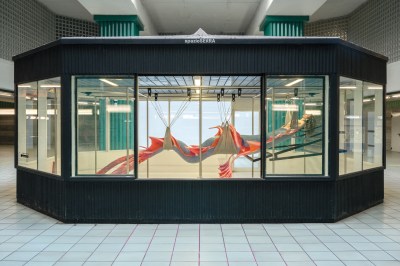It seemed fitting that my studio visit with Agnes Questionmark took place in the Brooklyn Navy Yard, as there’s an aquatic dimension to all her work. Her key preoccupation is the trans body, meaning at once transgender, transhuman, and trans-species, but if she could become anything, I believe it would be sea creature, with fins or tentacles, or both.
Questionmark is best known for elaborate multimedia performance works, but in between those, she keeps busy. Her current work starts with images printed on fabric, then over-painted with a mix of acrylic paint and silicone. Most are of hearts and other organs, in vivid reds and oranges, sensuous yet uncanny. She let me touch them. I wanted to press my cheek against them, but as we’d just met, it felt presumptuous to ask.
Related Articles
She shared with me some of her research material, her deep dive into specialized medical technology companies. One company has machines that keep human lungs, livers, and hearts going while awaiting transplants. Its website looks just like those for companies that sell industrial air conditioners or deep fryers: They enlist corporate aesthetics, but for human organ machines. “I’m interested in the usually unseen integration of flesh and tech,” she says.
Her favorite medium is silicone. It’s uncanny stuff, almost like flesh but not quite. It’s inert enough to stay inside the human body. Since both Questionmark and I are transgender, we talked about our experiences with body modification. Details I won’t share as they’re just for us girls. Being trans can lead to all sorts of adventures with the medical-industrial complex, although everyone’s body is enmeshed with machines in weird ways.
Agnes Questionmark: CHM13hTERT, 2023.
What else might a body become? That seems to be the question motivating Questionmark, particularly since her 2021 work TRANSGENESIS. Both an installation and a performance staged at Harlesden Highstreet in London, the work saw Agnes transformed into a giant hybrid creature, tentacles coiling beneath her. She gently waved her arms, as if in water, 8 hours a day for 23 days.
Later, in CHM13hTERT (2023), Questionmark again became some kind of chimeric sea creature, this time with fins. She spent 12 hours a day for 16 days in a glass enclosure at a subway station in Milan, suspended via slings and cables in a casing with a mermaid-like tail some 20 feet long. Something about monstrousness can be triggering: She tells me of viewers who yelled at her and banged on the glass. The title CHM13hTERT refers to a cell line developed to study the human genome. For Questionmark, this encoding means that, “perhaps one day, we will be able to modify it and shape it as we wish.”
Questionmark made a recent artist’s edition, QuestionGen (2024), in collaboration with biohacker Josie Zayner, and the Italian publisher Nero. It’s a single capsule containing a tiny bit of Agnes’ DNA, boxed up in a blister pack like a regular prescription drug, complete with a misinformation leaflet.
What I love about Questionmark is her infectious enthusiasm for exploring all the possibilities of flesh and tech, tempered by healthy critique. Beyond that, what intrigues me is the tension her work holds between beauty and the uncanny. Her work gives me hope that we can love things that turn out to be not what was expected, a feeling most trans people know well.
Credit: www.artnews.com






